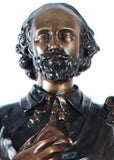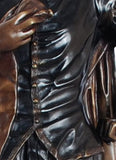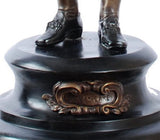Shakespeare Standing Statue Lost Wax Bronze Metal 37H
PN# 7892Shakespeare is elegantly dressed in this large statue. The Bard is ready to write a sonnet or play. He is dignified in his period costume and will make a beautiful additional to you home library. Shakespeare Standing Statue, Lost Wax Bronze is made from bronze metal according to centuries old casting methods, marble base. Black marble base. Measures: 37 in H x 14 in W x 14 in D.
Shakespeare penned the dramatic stories, plays, and poems that would become timeless classics. His masterpieces transcend into the human soul, as they can be found today, hundreds of years after his death around the globe. Can you imagine literature without Romeo and Juliet, King Lear, The Tempest or The Taming of the Shrew, just to name a few?
About William Shakespeare (1564-1616):
He was the son of John Shakespeare of Stratford and grandson of Richard Shakespeare of Snitterfield, both men of prominence. Shakespeare received a good education and studied Virgil and Ovid in Latin. He married Anne Hathaway in 1582 when he was 19 years old. She was seven years his senior. Their first child, Susanna, was baptized in May 1583 and twins were baptized in 1585. Soon after, Shakespeare moved to London. Hamnet, his only son died in 1596. By 1592, Shakespeare was an acknowledged playwright in London. However, the theaters were closed for two years due to riots and plague. The Globe Theater on the River Thames in London, was opened in 1599. Shakespeare was a part owner and he appeared there as an actor in 1600. The thatched roof of the theater caught fire during a performance on June 29th 1613 and the building was destroyed. This event is thought to have marked the end of Shakespeare's theatrical career and he moved back to Stratford. Thirty-six plays of Shakespeare were published in 1623. Eighteen in the First Folio were printed for the first time and 18, known as the Quartos, had previously appeared. Shakespeare wrote poems, but is better known for his sonnets, which were published in 1609.













